Cultivation of Dependent Origination
Dependent Origination is not just a theory; it is actually the basis of cultivation of the Eightfold Noble Path that leads directly to cessation of suffering. It is the background knowledge or theory against which one performs the various stages of the Path. One must understand the theory of operation of a computer or other complex machine as a background before diagnosing and repairing it without damaging it. Similarly, one must understand Dependent Origination as a background before repairing the errors in thinking that lead to dukkha.
Suffering manifests because vexation (any negative emotion like annoyance, irritation, exasperation, indignation, anger, crossness, displeasure, pique, bile, disgruntlement, bad mood or aggravation) originates a process of Dependent Origination, beginning from Ignorance to Aging-&-Death. The process begins from the emergence of Name-&-Form, and Consciousness based on it. We previously discussed this part of the process in detail in the section on Clinging. The Six Sense Bases arises next from Name-&-Form and Consciousness. Feeling originates from Contact of the Six Sense Bases with their objects; this generates vexation due to Craving and Clinging. Thereafter, Becoming and Birth follow in succession. This is the birth of the ego and possessiveness, ‘I’ and ‘mine’.
At this point, Suffering is experienced due to birth, aging, death, distress, sorrow, bitterness, worrying and irritation. The various kinds of suffering are simply called the Five Clinging Aggregates (pancupadanakkhandha) or dukkha. We previously discussed these in the section on the Five Clinging-Aggregates. In Dependent Origination, ‘death’ and ‘birth’ do not refer to physical death and birth. The birth and death of the physical body in everyday language has nothing to do with the Buddha’s teaching of Dependent Origination.
The Buddha’s purpose in teaching Dependent Origination is to totally abolish the concept of an ego or ‘self’. It is not enough to analyze the absence of an ego using the Five Aggregates; one must perceive the entire process of Dependent Origination clearly. Each of the Aggregates appears according to this/that conditionality (‘This exists therefore that exists; this ceases to be therefore that ceases to be’) once the eleven stages of Dependent Origination are complete. This enables us to better perceive the absence of an ego, delusion (vexation), kamma and karmic reaction (vipaka); or realize the absence of ego in the entire causal process. No ‘I’ or ‘mine’ can be found when the instantaneous phenomena of Dependent Origination are correctly perceived.
The concept behind the cultivation or practice of Dependent Origination is to stop the process. Stopping Dependent Origination means you short-circuit the process and go straight across to the equivalent stage of the Eightfold Noble Path. The earlier you can stop it, the better. Although it is more difficult to observe and stop Dependent Origination in its early stages, if you can, you wind up higher on the Eightfold Noble Path. The following illustrations give some examples of this technique:
Employing the Faith stage of the Eightfold Noble Path can eliminate much suffering and bring one quickly to Contentment. This stage of practice is seen among very pious religious Buddhists, who perform the practices of making offerings, Upostha (Poiya Day), following five Precepts.
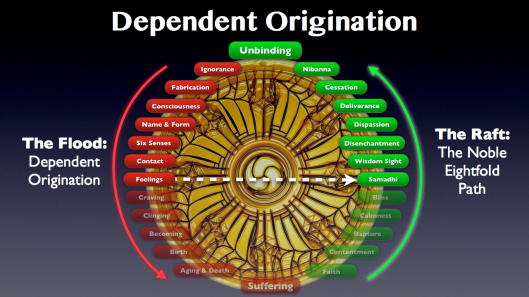
Attaining the Samadhi stage of the Eightfold Noble Path means stopping Dependent Origination at the stage of Feelings, eliminating the stages of Craving, Clinging, Becoming, Birth and Aging-&-Death, and quickly reaching the stage of Wisdom Sight (the Eye of the Dhamma). Note that this cultivation attainment gives the same or similar result as the Four Jhānas: the stages of Rapture, Calmness and Bliss of the Eightfold Noble Path.
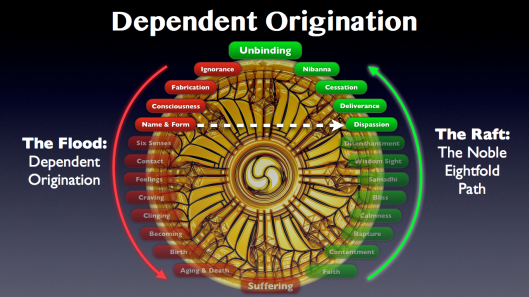
A very high stage of cultivation is the ability to stop the process of Dependent Origination at the stage of Name-&-Form. This automatically gives one Dispassion, leading very quickly to Deliverance from conditioned existence.
Totally stopping Fabrication would bring one immediately to Cessation of conditioned existence, opening the door to Nibbāna and final Unbinding. This is the level of cultivation of the Arahats.
We will examine the details of the practice in the section on the Third Noble Truth. For now, try to observe the process of Dependent Origination at work in your own experience. Especially, try not to let Contact proceed to the stage of Feelings. This means remaining neutral and equanimous toward one’s experience and not developing either pleasurable or displeasurable feelings about it.
Everyday Language and Dhamma Language ← Prev | Next → Name-&-Form and Consciousness

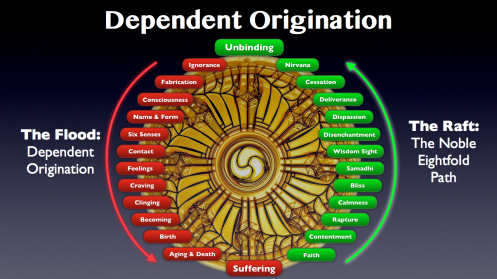
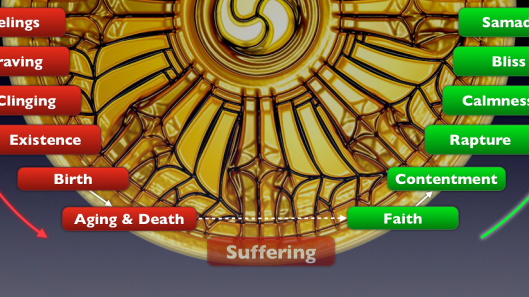
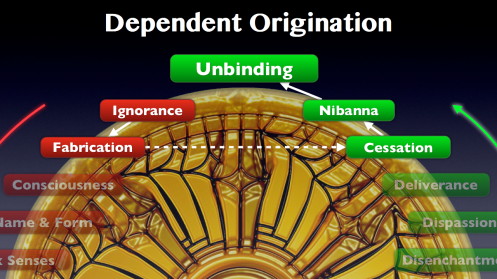
So, rapture, calmness, and bliss, as you stated, constitute the four jhanas- samadhi, in the diagram. This gives one the “platform” to see and know with direct knowledge the nature of phenomenon (five aggregates…)- in other words, wisdom sight. The Path continues until one reaches Unbinding.
But, my question is with regards to the higher jhanas, since they are not explicitly stated here. So, does this suggest that the attainment of higher jhanas is not required on the Path to Unbinding? Since Right Concentration is defined as the four jhanas, thus are higher attainments required?
After reading through Sutta passages, I understand there are many discussions of higher jhanas. In fact, there are many paths to Unbinding. There are many instances of persons entering the Stream simply by listening to a Dhamma talk (Ven. Ananda, Sariputta…). Others seem not to have even the attainment of the lower jhanas; rather they are mindful of the sense-media and enter the stream. The Buddha offered advice based on the individuals experience and background, thus, suggesting, again, different approaches to Release.
It seems to boil down to one’s kamma and how much meaningful wisdom one has acquired. Thus, those with the requisite kamma, such as Ven. Ananda, Sariputta and even a Brahma ( who, I believe attained stream-entry upon hearing a discourse from the Buddha) can progress quickly through the four stages (Stream, Once-Return…). However, take me for example, who might require more education, training, the proper context to progress.
Higher jhānas and samādhi are helpful, but not required on the path to insight (nibbāna). In fact they can become a distraction, just like mystical powers. There is a nice quote from Visuddhimagga:
The “ground” is the teaching of the Buddha. The “weapon” is the mind. The “stone” is concentration. Concentration (jhāna) must be practiced before insight; it is the basis for wisdom and insight (vipassana). Concentration, whether natural or consciously developed, is the stone on which the weapon is sharpened. One whose mind is naturally inclined towards concentration is very fortunate; others must work diligently to clear away the thick jungle of distractions.
Now, each of the various states of jhāna is a basis for insight—that is, an ontological platform for seeing impermanence, unsatisfactoriness and non-selfhood so penetratingly that the mind is freed from clinging. However, if the mind is too much absorbed in concentration, it is not possible to see these things. The qualities of the Formless Spheres lead to the Formless Absorptions (arūpa jhāna), high mental levels which, however, are not on the path to insight. In other words, one may attain insight without any practice of the higher jhānas.
First, thank you for answering all the questions I have been asking (on Skillful Living, jhānas, suggestions for Ergontics.com). I am trying to learn and participate in Dhamma.
The reason I have been asking so many questions about jhāna is based on two factors: 1) Their necessary function to insight and 2) Possible attachment, “In fact they [higher jhānas] can become a distraction, just like mystical powers” and ” if the mind is too much absorbed in concentration, it is not possible to see these things.”
I have not experienced any jhana, but I am trying to acquire as much information from the Suttas and clarification from you (and the Arahant previously) so, once I begin this practice, I progress rather than remained attached. In fact, the Path is all about non-clinging, emptiness, impermenance, directly seeing rise&fall of phenomena like you mentioned.
I am enjoying our dialogue. The feedback helps me understand the kind of material that will be useful to interested individuals, motivated to learn the Buddha’s teaching. You get what you pay for; thus, the more you participate the more benefit you will accrue.
There is always a difference between theory and practice. In theory, it’s good to know about the possibility of getting attached to jhāna; in practice, it’s almost impossible to prevent, and everyone has to struggle with it. Once tasting the attractiveness of jhāna, you will want to remain there indefinitely. And practice of jhāna is beneficial, even necessary for insight. So you have to walk the fine line between enough and too much.
Our life has to breathe. There should be room in it for change and development. After a long meditation retreat, there should be room for other experiences, tasting the changes in our being in contact with life and the world. The mind becomes attached by habit. So there will be resistance both to entering jhāna and to coming out of jhāna. Overcoming that resistance and maintaining flexibility is a natural and important part of our work.